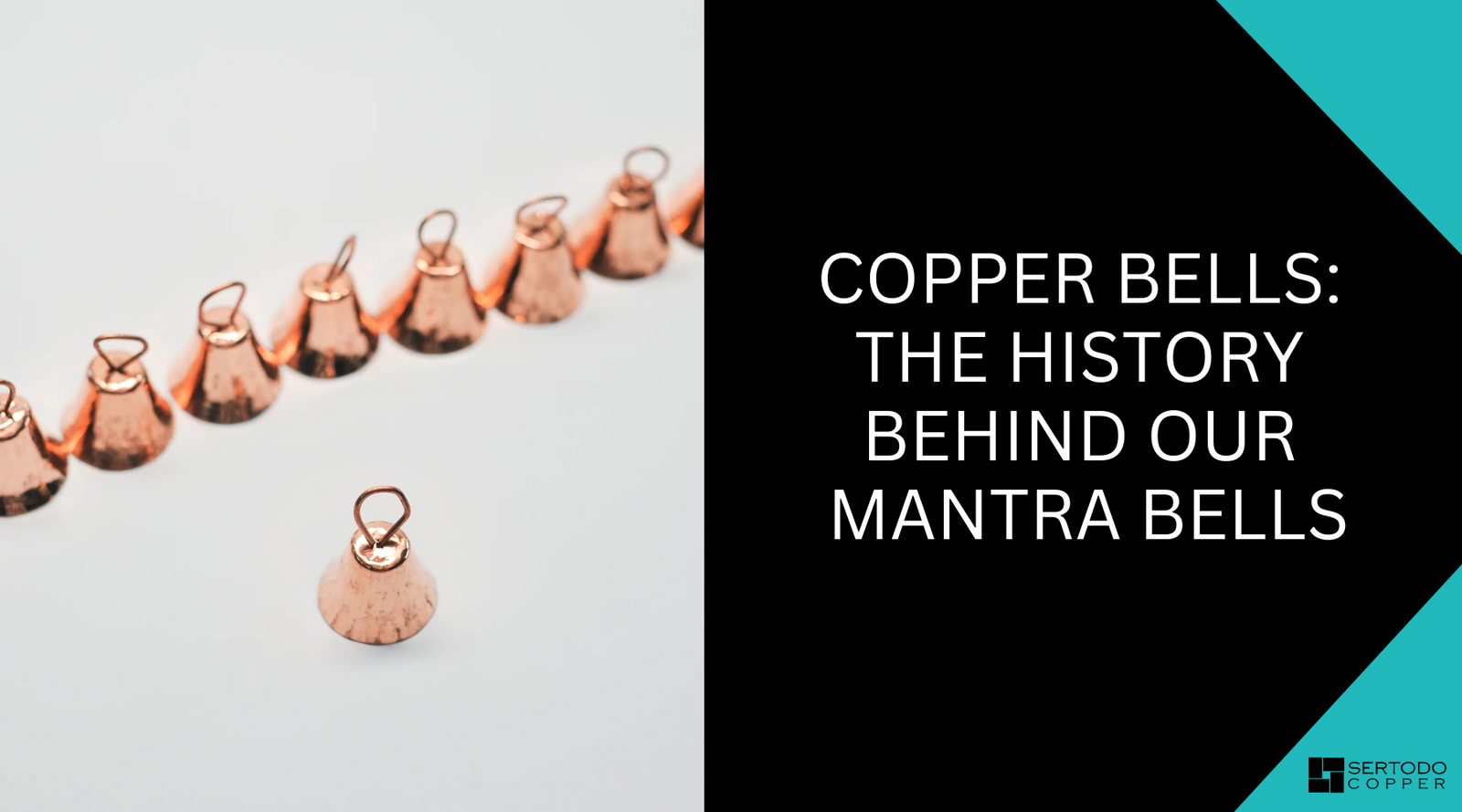An ally in the battle for a healthy civilization
We'd like to share with you a small window into the world of copper for your consideration. Consider in different light the subtle lustre this warm metal adds to our world, more than just the pink shine and the various patinas of its living finish.
Does copper kill viruses? Consider copper as a beautiful ally in the ongoing battle for a healthy civilization.
Spoiler alert for the copper vs. virus battle: It’s not a fair fight. Does copper kill viruses. Yep, every time.
Upon contact, copper releases ions (electrically charged particles) that begin to destroy the virulent cells completely, right down to its DNA and RNA, not allowing even a chance for mutation or the opportunity to pass on genes and develop resistance.
Copper is a very potent frontline defense against the spread, infection and mutation of influenzas, bacteria like E. coli, superbugs like Mersa, and even coronaviruses.
The History of Copper
Copper goes back further in human history than any other metal, more than 8000 years. In ancient Egypt, the Ankh was the symbol for eternal life, and also for copper. It is an abundant resource on our planet, and a resource that recycles very easily into new uses.
At least 65% of all copper that has ever been mined is still in use and circulation today. Perhaps this copper water dispenser I’m pouring a tall glass of water from began life as an Egyptian agricultural tool or religious ornament, then beaten into water pipes in ancient Persia, recast into Roman coins, melted down and formed into French Cookware, recycled and drawn into thin wire for electric motors, recuperated and again cast into plumbing for our American households, torn down and used in an air conditioning unit that made some home or office in the southern United states more habitable in the summer months till Sally blew the unit, cranking it down to 60 during the hottest August on record, where it went again to the recycle yard, sold as scrap and ended up in our shop, recast, rolled into sheet and turned into this gorgeous vessel for storing and serving clean, cool and delicious water to calmly sip while sheltering in place on a nice sunny day, perhaps…
Art, religion, architecture, cooking, electrical, plumbing, heating and air conditioning, medicine, hi-tech, new age, ancient wisdom… copper is tied to so many facets of human life that we could spend several books diving into each unique application of this metal. However, we are going to focus on copper and our health given the current global crisis brought about by the corona virus pandemic and our modern, connected, evolving world.
The knowledge linking copper and human health is nothing new under the sun. The first recorded medical use of copper dates from over 2000 B.C. in one of the oldest books known, The Smith Papyrus of ancient Egypt. Egyptian, Phoenician, Greek, Roman, Persian, Indian, Mongol, Aztec, Inca; all of these ancient civilizations recognized copper as vital to health. It was as an important element in their medical traditions to address and cure a long list of ailments: headaches, inflammation, sore throats associated with infection, prevent infection in wounds, joint pain, epilepsy, chronic ulcers, eye issues… and even to purify water for drinking.
Copper And Ayurvedic Medicine
Ayurvedic medicine, still widely practiced today, is an ancient Indian medical tradition incorporating copper for health and longevity. It is a prevention oriented, natural and holistic health care. Storing water in a copper vessel for drinking is one of the fundamental practices of Ayurveda. It calls for water to be stored in copper and a cup full to be drunk first thing in the morning to balance the three Doshas, (or energies), of the body and ensure the proper functioning of the different organs and metabolic processes. Among the benefits associated with this practice: boost the immune system, improve hair, skin, bone and joint condition, aid in digestion, strong antioxidant properties, improved cognitive function.
Modern civilization began to awaken again to the healing properties of copper as the Industrial Revolution gained steam. Given the newly concentrated populations of Europe, cholera and typhoid epidemics swept through the 1800’s on several occasions and offer relevant comparisons for our current situation. Victor Burq, a French medical researcher in the 1800’s discovered that during the 1832 and 1849 epidemics, no workers in industries associated with copper (such as jewelers, foundry workers, burnishers, boilermakers, etc.) died from Cholera, and only few were ill with mild symptoms of the pandemic illness.
The subsequent 1854-1855 epidemic strengthened his conviction that copper was effective both preventively and curatively. Burq successfully advocated for copper treatment in the form of salts and oxides ingested in small doses against these illnesses and infections. They were used until the invention of antibiotics early in the 20 th century. Dosage and delivery are again being worked on in modern medical science. Copper can be toxic in large amounts and will induce vomiting. Please do not take this as medical advice to scrape your copper pots and sprinkle it on your cheerios!
Based on the historical data and references for copper, many researchers anticipate copper becoming an important component of tomorrow’s medical treatments, especially considering the virulent strains of bacteria and viruses developing resistance to antibiotics. Modern research on copper and medicine begun in the 1960’s has been showing it’s efficacy in the treatment of inflammatory diseases, wound and ulcer healing, anticonvulsants, anticancer, anticarcinogenic, radiation protection and recovery, and heart disease… many of the same areas of health where the ancients used this metal thousands of years ago. Explore our collection of ayurvedic copper here.
Modern Use Of Copper to Kill Viruses
Modern science is gaining a clearer picture into the mechanisms by which copper impacts the health of our bodies. Copper appears in the plasma of a stressed human body (from illness or injury) at 2 to 3 times the normal level. The natural copper complexes in the body expedite the relief of stress and the repair of tissues while organic complexes of copper have medicinal capabilities that are fundamental to the body’s healing process.
Let’s bring this discussion outside, to the world we all go shopping in, to the mall, to the doctor’s office, to the train station, to the airport, to the restaurant or bar, to the park, to the show… to the world of sneezes, coughing, dirty hands, shared surfaces, door handles, push plates, countertops, railings, toilet seats, phone cases, hospitals, and anything else we touch, potentially infect and possibly transmit disease.
There’s a reason the Spartans sprinkled copper powder and oxides on open wounds from battle, to prevent infection. This is now known as the Oligodynamic effect: copper releases ions that destroy bacteria, fungi, spores and viruses.
Copper and brass were once the materials of choice for manufacturing home goods and architectural elements. This has changed over the past sixty or seventy years as shinier and economically cheaper alternatives have been developed and become more readily available, such as aluminum, stainless steel, chrome, plastic, rubber. Shiny, cheap, we love it! So does Staph, E Coli and Corona Virus!
How does copper kill viruses?
Bacteria and microbes can live for days on many of these commonly used materials such as aluminum, steels, ceramics, and plastic, even showing heavy growth of microbes. However, with copper and high copper alloys such as brass and bronze, these bacteria and microbes begin to die on contact. The most recent study shows that the corona virus dies completely within 4 hours of contact with a copper surface, 24 hours on cardboard, and 2-3 days on stainless steel and plastics. That dull piece of patinaed copper? Yes, it is killing virus and bacteria. Even tarnished copper metals retain their strong antimicrobial and antiviral properties.
In 2015, researchers found that when copper was used in three different hospitals, infection rates were reduced by 58%. Stainless steel or chrome plated fixtures are cheap relative to copper or brass materials.
Hospital borne infections are not cheap, costing the healthcare system up to $45 Billion and killing as many as 90,000 people per year. The cheap and shiny alternatives are not cheap or as attractive when we look at the deeper costs to our health and society.
I’d like to share some personal testimony. As you may imagine, my house is filled with everything copper, countertops, sinks, cookware, cups, and has been since we built it twelve years ago. Three years ago, I made our first copper water dispenser and brought it into the house to use for all our drinking and cooking water. There has been a subtle, but significant change I realized late last year as everyone else seemed to be coming down with something while the holiday season rolled in – the small colds and flus that ran through our household several times a year have been minimized, affecting us at most for only two or three days as opposed to the seven to ten days in previous years.
As I write this in 2020, we were in the midst of the greatest pandemic our world has ever collectively witnessed. Touching, handling and using copper puts a break in the transmission train of the Corona Virus. Does copper kill viruses? It does.
Much of the knowledge gathered here has come in bits and pieces over my 23 years working with this metal. I appreciate the opportunity these recent events have provided to share some insight I can offer from my experience to your community, to dive deeper into the topic of copper and health in relation to our current crisis. Do consider bringing more of the subtle lustre of this healthy metal into your life.
Further Reading: Does copper kill viruses?
Sertodo Copper’s Ayurvedic Collection
Sertodo Copper’s Copper Drinkware
Want to know more about copper and its correlation to the novel coronavirus? Check out the info below:
Economic burden of healthcare-associated infections: an American perspective
New Coronavirus stable for hours on surfaces




